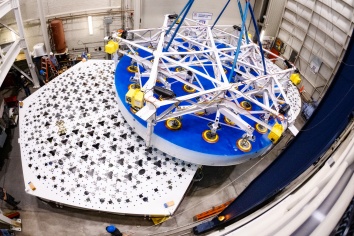
Completed 8.4-meter-diameter primary mirror installation into its support system prototype at the University of Arizona’s Richard F. Caris Mirror Lab. Image credit: Damien Jemison, Giant Magellan Telescope – GMTO Corporation.
15 October 2024
The Giant Magellan Telescope, of which The University of Texas at Austin is a founding partner, today announced the successful installation of one of its completed 27.6-foot-diameter (8.4-meter-diameter) primary mirrors into a support system prototype at the University of Arizona’s Richard F. Caris Mirror Lab. This highly sophisticated system — comparable in size to half a basketball court and containing three times the number of parts of a typical car — is vital to the telescope’s optical performance and precision control. The milestone marks the start of a six-month optical testing phase to demonstrate that the support system can control the mirror as required, validating the revolutionary capabilities of the telescope’s primary light-collecting surface.
The Giant Magellan’s 1,207-square foot (368-square-meter) light-collecting surface is composed of seven of the world’s largest optical mirrors arranged in a unique flower pattern. Together, they will provide the highest image resolution over the widest field of view ever achieved for the exploration of the universe — delivering up to 200 times the power of today’s best telescopes.
“Astronomers the world over are looking forward to the deep views of the cosmos that this powerful telescope will unlock,” said Taft Armandroff, director of The University of Texas at Austin’s McDonald Observatory. “Its trailblazing design and intricate assembly are a true testament to what the Giant Magellan Telescope partner community can achieve when working toward a common goal.”
Each primary mirror weighs 18.7 tons (17-metric tons) and is supported by a highly specialized pneumatic support system which is housed in a steel weldment, or “cell.” This system works with nanometer precision, and is designed to adjust the mirror’s position, stabilize its temperature, protect it from seismic activity, and maintain its precise shape by mitigating mirror sagging from gravity as the telescope moves. The system controls the combined seven primary mirrors to act as a single light-collecting surface, creating the optimal conditions for peak optical performance during scientific observations.
“This work is funded by a National Science Foundation award,” said Barbara Fischer, primary mirror subsystem manager for the Giant Magellan Telescope. “We began integrating the active support prototype system more than three years ago, and we first used a steel mirror mass simulator to demonstrate that our design was able to safely support and control the completed primary mirror segments. I am honored to work with an extraordinary team, and it is exciting to finally see a completed mirror segment integrated with the cell.”
While the actual installation of the mirror into the cell took only one day, the process began with four weeks of disassembly to prepare the cell and support system for transport. The system was then moved 20 miles (32 kilometers) from the University of Arizona’s Tech Park to the Richard F. Caris Mirror Lab for reassembly. This logistically complex operation occurred a few hours after midnight to minimize traffic disruptions, as the wide-load cell required two road lanes for transport.
“The Giant Magellan Telescope’s primary mirror active support system is the first of its kind,” said Trupti Ranka, principal opto-mechanical control systems engineer for the Giant Magellan Telescope. “The active support system contains an array of approximately 200 actuators and sensors to control the position and shape of the 17-metric tons [18.7 tons], 8.4-meter [27.6 foot] mirror within a fraction of a micron. The control system allows a harmonious operation between the sensor data and actuators to achieve this precision.”
Now that one of the primary mirrors has been successfully integrated with the support system prototype, it will undergo rigorous testing under a metrology tower at the Richard F. Caris Mirror Lab to confirm that the mirror can maintain its shape and performance under various operational conditions. Once testing is complete, the design for the active support systems will undergo a final design review, and production will commence in 2027.
“This intricate system took years of designing, building, and testing by a team of specialized engineers and technicians,” said Tomas Krasuski, principal software and system test engineer for the Giant Magellan Telescope. “Every single component was thoroughly tested before integrating it into the system. Now that we’ve installed the mirror segment, we are excited to validate its performance. It has been a challenging yet rewarding process to get here.”
The milestone highlights the next stage of advancement for the Giant Magellan Telescope’s seven primary mirror segments and their support systems. Three of the primary mirror segments are complete, while the remaining four are in various stages of polishing. The seventh and final primary mirror was cast in October 2023 and is now being prepared for polishing. This latest milestone also follows the August 2024 start of the Giant Magellan’s 128-foot-tall (39-meter-tall) telescope mount structure assembly at Ingersoll Machine Tools in Rockford, Illinois, which will support the seven primary mirrors and their cells, adaptive optics, and scientific instruments.
“For the first time, a completed primary mirror segment has been integrated into its support system — this is a giant step in our journey toward first light,” said William Burgett, project manager for the Giant Magellan Telescope. “Once its performance is validated, we will begin manufacturing all seven mirror cells at Ingersoll Machine Tools, which will be one of the most exciting advancements to date.”
The Giant Magellan Telescope is now 40 percent under construction across 36 states and on track to be operational in Chile by the early 2030s.

Completed 8.4-meter-diameter primary mirror installation into its support system prototype at the University of Arizona’s Richard F. Caris Mirror Lab. Image credit: Damien Jemison, Giant Magellan Telescope – GMTO Corporation.

Image credit: Damien Jemison, Giant Magellan Telescope – GMTO Corporation.